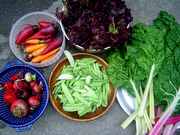

|
| Vegetable Varieties for Gardeners is a citizen science program
|
|
|
|
'Golden Globe' Turnips |
| |
| Sub-Category: |
None
|
| |
|
| Sub-Category 2: |
| | Description: |
Plants produce golden-fleshed roots.
|
| Days To Maturity: |
NA
|
| Seed Sources: |
|
| |
| Rating Summary |
| |
Overall: (5.0 Stars)
Taste: (5.0 Stars)
Yield: (5.0 Stars)
Ease/Reliability: (5.0 Stars) |
| |
| Reviews |
| |
Login to share your Review of Golden Globe.
Number of Reviews: 2
KEY: O=Overall Rating, T=Taste, Y=Yield, E=Ease
Reviewed on 01/07/2016 by
Jeremiah
- An intermediate gardener
|
 Overall Overall
 Taste Taste
 Yield Yield
 Ease Ease
|
Rockcastle, Kentucky, United States
Frost Free Season: 163 - 183 days
Soil Texture: Clay
Garden Size: Medium - 400 square feet to 1,600 square feet
Sun Exposure: More than 8 hours per day
|
| Large turnip with unusually mild, crisp, cream-colored flesh, similar to a rutabaga in flavor. Golden Globe's ample tops are probably perfectly serviceable as greens, but I grew them for the outstanding roots alone. Some of these were the size of large rutabagas, but were not woody or hollow-hearted.
I purchased the seed from everwilde.com. They were grown in medium-heavy soil amended with a touch of compost and hardwood ashes and well-mulched with straw. Planting was in late August and I am still (as of January 7) harvesting fine turnips. |
| |
|
Reviewed on 08/14/2009 by
a_hermit
- An experienced gardener
|
 Overall Overall
 Taste Taste
 Yield Yield
 Ease Ease
|
Tompkins, New York, United States
Frost Free Season: 143 - 163 days
Soil Texture: Clay
Garden Size: Medium - 400 square feet to 1,600 square feet
Sun Exposure: 6 to 8 hours per day
|
Seeds from High Mowing Organic Seeds.
Fantastic turnip. Great taste, not too woody even through July in CNY. (Cool year.) Harvested 3-5". Big turnipy plants, thin appropriately. No problems whatsoever, did fine in medium clay. Golden colored flesh throughout. |
| |
|
|
|
|
Vegetable Varieties for Gardeners is a citizen science program, © 2004-2024, All Rights Reserved
Cornell Garden Based Learning, Cornell University College of Agriculture & Life Sciences, Horticulture Section
|






 VVfG home
VVfG home


